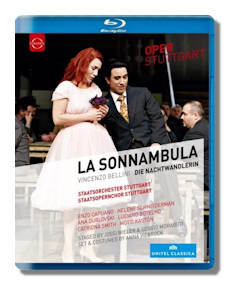
The Internet's Premier Classical Music Source
Related Links
- Bellini Reviews
- Latest Reviews
- More Reviews
-
By Composer
-
Collections
DVD & Blu-ray
Books
Concert Reviews
Articles/Interviews
Software
Audio
Search Amazon
Recommended Links
Site News
 Blu-ray Review
Blu-ray Review
Vincenzo Bellini

La Sonnambula
- Amina - Ana Durlovski
- Elvino - Luciano Botelho
- Lisa - Catriona Smith
- Il Conte Rodolfo - Enzo Capuano
- Teresa - Helene Schneiderman
- Alessio - Motti Kastón
Stuttgart State Opera Chorus/Johannes Knecht
Stuttgart State Orchestra/Gabriele Ferro
Jossi Wieler and Sergio Morabito - Stage Directors
Anna Viebrock - Sets and Costume Design
Reinhard Traub - Lighting Design
Recorded live at the Oper Stuttgart, June 2013
EuroArts/Unitel Classica Blu-ray 2059334 156m LPCM Stereo DTS-HD Master Audio
Also available on DVD 2059338: Amazon - UK - Germany - Canada - France - Japan - ArkivMusic - CD Universe - JPC
This is a fine effort on all counts, from the singing and orchestral playing to the stage direction, sets and costuming. It's easy to see why this production was given the 2012 Opera of the Year award by the highly respected German magazine Opernwelt. It should be noted that this performance was recorded a year after the award was given, but it nevertheless employed the company's same production assets. This is an updated take on Bellini's masterpiece, moving the setting into the 20th or perhaps 21st century. Actually, judging from the sets and the outfits worn by the principals and other onstage singers, I would say the action takes place in the latter quarter or so of the 20th century. The story of La Sonnambula is well known, but I'll give a very brief summary anyway. Amina, betrothed to Elvino, temporarily ruins things when she sleepwalks into Rodolfo's bedroom and is caught with him. Elvino denounces her as unfaithful and selects the deceitful Lisa to wed. Amina is finally cleared by Teresa, the woman who raised her, and all ends well.
The star of the opera is Ana Durlovski (Amina), a Macedonian soprano with the talent to become a superstar. Her first big number, Come per me serano, is beautifully sung. Her high notes here and throughout are simply astonishing. Amina's First Act duet (Prendi, l'anel ti dono) with Elvino, brilliantly portrayed by Luciano Botelho, is another great success. Botelho is obviously another talent to watch. Veterans Helene Schneiderman as Teresa and Enzo Capuano as Rodolfo also turn in splendid performances. Catriona Smith as Lisa must also be highly praised: her dramatic skills are especially outstanding in portraying the cynical and opportunistic village innkeeper.
Gabriele Ferro infuses the score with much spirit and color and draws wonderful performances from the chorus and orchestra of the Stuttgart Opera. The sets are rather simple but quite effective in conveying the sense the villagers are more blue-collar than impoverished: the opening scene takes place in the inn, which resembles a large cafeteria with many folding tables and benches. It has the kind of appearance of a lunch room in a factory or other blue collar workplace. Rodolfo's bedroom is modestly furnished as well, and mostly everything else on stage conveys a kind of proletarian simplicity. That said, the stage is never barren, as you see not only many tables and benches, but cabinets, doors, entrance ways and stairways. It all works well, not least because the stage also has considerable depth, plenty of space for the big choral numbers. The attire of the principals and chorus members on stage is modest but effective. Lighting, camera work, and picture clarity are outstanding. The sound reproduction is also first rate. In sum, this is a splendid performance of Bellini's opera and features one, possibly two potential superstars of the operatic stage.
Copyright © 2014, Robert Cummings





















